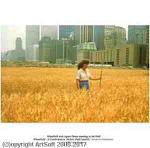Agnes Denes
Agnes Denes
Place: Budapest
Born: 1938
Biography:
Agnes Denes is a Hungarian-born American conceptual artist based in New York. She is known for works in a wide range of media - from poetry and philosophy writings, to complex hand and computer rendered diagrams (which she terms Visual Philosophy), sculpture, and international environmental installations, such as Wheatfield -- A Confrontation (1982), a two-acre wheatfield in downtown Manhattan.
Born in Budapest, Hungary in 1931, her family survived the Nazi occupation and moved to Sweden in the mid-1940s. When she was a teenager, they relocated again to the United States. She has said that the repeated change in language caused her to focus on the visual arts - having "suddenly been silenced." She studied painting at the New School and Columbia University in New York, and exhibited and sold some of her work. She soon abandoned painting, due to the constraints of the canvas, and focused broadly on ideas she could explore in other mediums. "I found its vocabulary limiting"
In the early 1970s, she joined the A.I.R. Gallery as a founding member and in fact, she left an uptown gallery to join.
She has since participated in more than 450 exhibitions at galleries and museums throughout the world, and has written 6 books. At some point in the late 1960s-1970s, she was married and has one son, Robert T. Frankel.
What ties it all together is Ms. Denes's insistence on marrying ambitious intellectual ideas with exquisite formal execution. In contrast to many of her conceptual and land-art peers, she has always been deeply involved with drawing.
In the history of art there have been a few artists' artists—individuals who have emphasized in their work the raising of provocative questions and who have also tested the limits of art by taking it into new, unforeseen areas and by using it for distinctly new functions. Agnes Denes is one of these special artists.
During her time at Artpark, Denes recreated her Rice/Tree/Burial piece from 1968. In 1977, she planted half acre of rice 150 feet above the spot where Niagara Falls has originally formed. The land itself that she worked on was known to have been an industrial dumping ground, which affected the quality of the rice. In 1978, she continued the project by chaining together trees in the forest in the park to symbolize interference with growth. On August 20, 1979, Denes buried her haiku poems at 47°10' longitude, 79°2'32 latitude set to be opened in the twenty-third century. The capsule also includes microfilmed responses of university students to questions about the nature of humanity. Along with the rice, time capsule, and ceremonial chaining of trees in the park, Denes filmed footage of Niagara Falls for this iteration of Rice/Tree/Burial to "add natural force as the fourth element and fuse the other three". Her poetry that she included as well as personal accounts of her experiences working on this series in the park is featured in the 1977 Artpark Program in the Visual Arts.
Researcher Jennifer Seaman Cook argues that Artpark's public funding for experimentation was instrumental in the development of Denes' work, precursing her 1982 field of wheat project overlooking the Twin Towers from Battery Park. The Artpark residency program gave artists the space to experiment with these themes in land art and other emergent media.
Ms. Denes as a highly original thinker and visualizer whose work rewards the close attention it demands. -Grace Glueck, New York Times.
Agnes Denes drawings in the permanent collection of the Smithsonian Institution Museums
Beginning in 1968, she began an intensive exploration of philosophy through art. The result was "an amazing body of work, distinguished by its intellectual rigor, aesthetic beauty, conceptual analysis, and environmental concern." -Jill Hartz, retrospective editor, Cornell University
Original drawings for Isometric Systems, from the Museum of Modern Art Collection
A gallery exhibition can only suggest how far and wide the polymathic Ms. Denes has ranged over material and mental worlds during the past four decades. It would take a full-scale museum retrospective to do that.
Denes has over ten works in the Museum of Modern Art's collection. In the Metropolitan Museum, the artist has five pieces in the permanent collection. At the Whitney Museum of American Art, Denes has three pieces in the permanent collection. Beyond that, the artist has work in forty-three additional museum permanent collections. She is currently represented by Leslie Tonkonow Artworks + Projects, New York.
More...
Wikipedia link: Click Here



